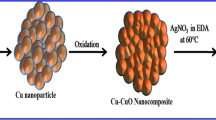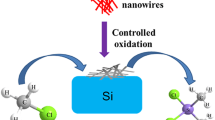Abstract
The synthesis of well-defined copper core-silver shell nanowire by a modified hydrothermal method followed by immersion coating process is reported here. The HRTEM image of the individual Cu–Ag core-shell nanowire successfully demonstrates that the silver nanocrystals were effectively deposited over the surface of Cu nanowires, resulting in a core-shell structure by the immersion coating process. The catalytic performance of the prepared copper core-silver shell nanowires with different ratios have been investigated by taking the reduction of para nitrophenol to para aminophenol in presence of sodium borohydride as the model reaction. The Cu–Ag core-shell nanowires show remarkable catalytic activity toward the reduction of p-nitrophenol at room temperature with a maximum apparent rate constant value of 0.216 min−1. In comparison with the monometallic copper nanowires, the Cu–Ag core-shell nanowires exhibit 3.5 times enhancement in the catalytic performance and good recyclability for at least three cycles of the reduction reaction.
Graphic abstract
Copper core-silver shell nanowire: a potential catalyst for the reduction of paranitrophenol was developed by a modified hydrothermal method followed by immersion coating process. Remarkable catalytic activity with a maximum apparent rate constant value of 0.216 min−1 was obtained. The use of eco-friendly reducing agent and the high purity synthetic approach makes this work significant.












Similar content being viewed by others
References
Pradhan N, Pal A and Pal T 2002 Silver nanoparticle catalyzed reduction of aromatic nitro compounds Colloids Surf. A Physicochem. Eng. Asp. 196 247
Baruah B, Gabriel G J, Akbashev M J and Booher M E 2013 Facile synthesis of silver nanoparticles stabilized by cationic polynorbornenes and their catalytic activity in 4-nitrophenol reduction Langmuir 29 4225
Pandey S and Mishra S B 2014 Catalytic reduction of p-nitrophenol by using platinum nanoparticles stabilised by guar gum Carbohydr. Polym. 113 525
Du Y, Chen H, Chen R and Xu N 2004 Synthesis of p-aminophenol from p-nitrophenol over nano-sized nickel catalysts Appl. Catal. A-Gen. 277 259
Yu W, Porosoff M D and Chen J G 2012 Review of Pt-based bimetallic catalysis: from model surfaces to supported catalysts Chem. Rev. 112 5780
Sankar M, Dimitratos N, Miedziak P J, Wells P P, Kiely C J and Hutchings G J 2012 Designing bimetallic catalysts for a green and sustainable future Chem. Soc. Rev. 41 8099
Singh A K and Xu Q 2013 Synergistic catalysis over bimetallic alloy nanoparticles. Chem. Cat. Chem. 5 652
Zhao W, Yang L, Yin Y and Jin M 2014 Thermodynamic controlled synthesis of intermetallic Au 3 Cu alloy nanocrystals from Cu microparticles J. Mater. Chem. A 2 902
Sun Y, Zhang F, Xu L, Yin Z and Song X 2014 Roughness-controlled copper nanowires and Cu nanowires–Ag heterostructures: synthesis and their enhanced catalysis J. Mater. Chem. A 2 18583
Han M, Liu S, Zhang L, Zhang C, Tu W, Dai Z and Bao J 2012 Synthesis of octopus-tentacle-like Cu nanowire-Ag nanocrystals heterostructures and their enhanced electrocatalytic performance for oxygen reduction reaction ACS Appl. Mater. Interfaces 4 6654
Rathmell A R, Bergin S M, Hua Y L, Li Z Y and Wiley B J 2010 The growth mechanism of copper nanowires and their properties in flexible, transparent conducting films Adv. Mater. 22 3558
Mohl M, Pusztai P, Kukovecz A, Konya Z, Kukkola J, Kordas K, Vajtai R and Ajayan P M 2010 Low-temperature large-scale synthesis and electrical testing of ultralong copper nanowires Langmuir 26 16496
Jin M, He G, Zhang H, Zeng J, Xie Z and Xia Y 2011 Shape‐controlled synthesis of copper nanocrystals in an aqueous solution with glucose as a reducing agent and hexadecylamine as a capping agent Angew. Chem., Int. Ed. 50 10560
Zhang D, Wang R, Wen M, Weng D, Cui X, Sun J, Li H and Lu Y 2012 Synthesis of ultralong copper nanowires for high-performance transparent electrodes J. Am. Chem. Soc. 134 14283
Li S, Chen Y, Huang L and Pan D 2014 Large-scale synthesis of well-dispersed copper nanowires in an electric pressure cooker and their application in transparent and conductive networks Inorg. Chem. 53 4440
Sharma V, Singh I and Chandra A 2018 Origin of superior catalytic activity in copper (II) oxide nanoflakes in comparison to solid or even hollow particles Mater. Lett. 211 285
Zhang Y, Zhu P, Li G, Chen L, Cui C, Zhang K, Sun R and Wong C 2018 Easy separation of CuO nanocrystals with high catalytic activity Mater. Lett. 212 332
Otari S, Yadav H, Thorat N, Patil R, Lee J and Pawar S 2016 Facile one pot synthesis of core shell Ag@ SiO2 nanoparticles for catalytic and antimicrobial activity Mater. Lett. 167 179
Mao Y, Wei J, Wang C, Feng Y, Yang H and Meng X 2015 Growth and characterization of sponge-like silver with high catalytic activity for the reduction of p-nitrophenol Mater. Lett. 154 47
Kong X, Zhu H, Chen C, Huang G and Chen Q 2017 Insights into the reduction of 4-nitrophenol to 4-aminophenol on catalysts Chem. Phys. Lett. 684 148
Bhanushali S, Ghosh P, Ganesh A and Cheng W 2015 1D copper nanostructures: progress, challenges and opportunities Small 11 1232
Yang H J, He S Y and Tuan H Y 2014 Self-seeded growth of five-fold twinned copper nanowires: mechanistic study, characterization, and SERS applications Langmuir 30 602
Ye E, Zhang S Y, Liu S and Han M Y 2011 Disproportionation for growing copper nanowires and their controlled self‐assembly facilitated by ligand exchange Chem. Eur. J. 17 3074
He X, He R, Lan Q, Duan F, Xiao J, Song M, Zhang M, Chen Y and Li Y 2016 A facile fabrication of silver-coated copper nanowires by galvanic replacement J. Nanomater. 2016 1
Khan F U, Khan S B, Kamal T, Asiri A M, Khan I U and Akhtar K 2017 Novel combination of zero-valent Cu and Ag nanoparticles@ cellulose acetate nanocomposite for the reduction of 4-nitro phenol Int. J. Biol. Macromol. 102 868
Ismail M, Khan M, Khan S B, Khan M A, Akhtar K and Asiri A M 2018 Green synthesis of plant supported CuAg and CuNi bimetallic nanoparticles in the reduction of nitrophenols and organic dyes for water treatment J. Mol. Liq. 260 78
Aditya T, Pal A and Pal T 2015 Nitroarene reduction: a trusted model reaction to test nanoparticle catalysts Chem. Comm. 51 9410
Liu J, Qin G, Raveendran P and Ikushima Y 2006 Facile “green” synthesis, characterization, and catalytic function of β‐D‐glucose‐stabilized Au nanocrystals Chem. Eur. J. 12 2131
Che W, Ni Y, Zhan Y and Ma Y 2015 Morphology-controllable synthesis of CuO nanostructures and their catalytic activity for the reduction of 4-nitrophenol J. Phys. Chem. Solids 77 1
Wunder S, Polzer F, Lu Y, Mei Y and Ballauff M 2010 Kinetic analysis of catalytic reduction of 4-nitrophenol by metallic nanoparticles immobilized in spherical polyelectrolyte brushes J. Phys. Chem. C 114 8814
Vannice M 2005 Reactions Springer Science+ Business Media: Philadelphia, PA.
Wu W, Lei M, Yang S, Zhou L, Liu L, Xiao X, Jiang C and Roy V A 2015 A one-pot route to the synthesis of alloyed Cu/Ag bimetallic nanoparticles with different mass ratios for catalytic reduction of 4-nitrophenol J. Mater. Chem. A 3 3450
Das S and Jana S 2015 A facile approach to fabricate halloysite/metal nanocomposites with preformed and in situ synthesized metal nanoparticles: a comparative study of their enhanced catalytic activity Dalton Trans. 44 8906
Sasmal A K, Dutta S and Pal T A 2016 ternary Cu2O–Cu–CuO nanocomposite: a catalyst with intriguing activity Dalton Trans. 45 3139
Kamal T, Khan S B and Asiri A M 2016 Synthesis of zero-valent Cu nanoparticles in the chitosan coating layer on cellulose microfibers: evaluation of azo dyes catalytic reduction Cellulose 23 1911
Lü J, Fu Y, Song Y, Wang D and Lü C 2016 Temperature-dependent catalytic reduction of 4-nitrophenol based on silver nanoclusters protected by a thermo-responsive copolymer ligand RSC adv. 6 14247
Wang C, Xu C, Zeng H and Sun S 2009 Recent progress in syntheses and applications of dumbbell‐like nanoparticles Adv. Mater. 21 3045
Li P, Wei Z, Wu T, Peng Q and Li Y 2011 Au–ZnO hybrid nanopyramids and their photocatalytic properties J. Am. Chem. Soc. 133 5660
Lim B, Kobayashi H, Yu T,Wang J, Kim M J, Li Z Y, Rycenga M and Xia Y 2010 Synthesis of Pd–Au bimetallic nanocrystals via controlled overgrowth J. Am. Chem. Soc. 132 2506
Hammer B, Hansen L B and Nørskov J K 1999 Improved adsorption energetics within density-functional theory using revised Perdew-Burke-Ernzerhof functionals Phys. Rev. B 59 7413
Hammer B and Nørskov J 1995 Electronic factors determining the reactivity of metal surfaces Surf. Sci. 343 211
Hammer B, Morikawa Y and Nørskov J K 1996 CO chemisorption at metal surfaces and overlayers Phys. Rev. Lett. 76 2141
Acknowledgements
RK and BKV acknowledge the funding from KSCSTE project (order no. 1562/2016/KSCSTE). We also acknowledge Kannur University for providing the grant by minor research project (Pl. D./A2/UGC- Minor R. P/2018).
Author information
Authors and Affiliations
Corresponding author
Rights and permissions
About this article
Cite this article
KOTTAPPARA, R., PALANTAVIDA, S. & VIJAYAN, B.K. Enhanced reduction reaction by Cu–Ag core-shell nanowire catalyst. J Chem Sci 132, 115 (2020). https://doi.org/10.1007/s12039-020-01814-0
Received:
Revised:
Accepted:
Published:
DOI: https://doi.org/10.1007/s12039-020-01814-0




